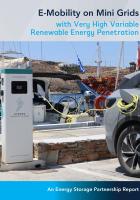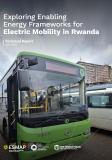Publications
Countries are increasingly adopting electric vehicles (EVs) to decarbonize transportation, with particular interest in mini grids and islands as prototypes for larger systems. Integrating EV charging with renewable energy sources (RES) in isolated mini grids presents operational challenges due to grid limitations, such as supply variability and low inertia, which can cause frequency instability and blackouts. Advanced inverter controls and battery energy storage are essential for maintaining grid stability and supporting operational security. While EV charging can strain grid infrastructure and affect power quality, these issues can be mitigated through active charging management and grid investments. Synergies between EVs and RES can lower energy costs, increase hosting capacity, and reduce CO2 emissions. The report reviews current e-mobility practices in mini grids, highlights the benefits and challenges of EV-RES integration, and emphasizes the need for strategic planning, project funding, and support for energy storage, including second-life EV batteries, to achieve high renewable penetration and transportation electrification.
Energy Sector Management Assistance Program (ESMAP). 2025.
E-Mobility on Mini Grids with Very High Variable Renewable Energy Penetration. ESMAP Papers. Washington DC: World Bank.




